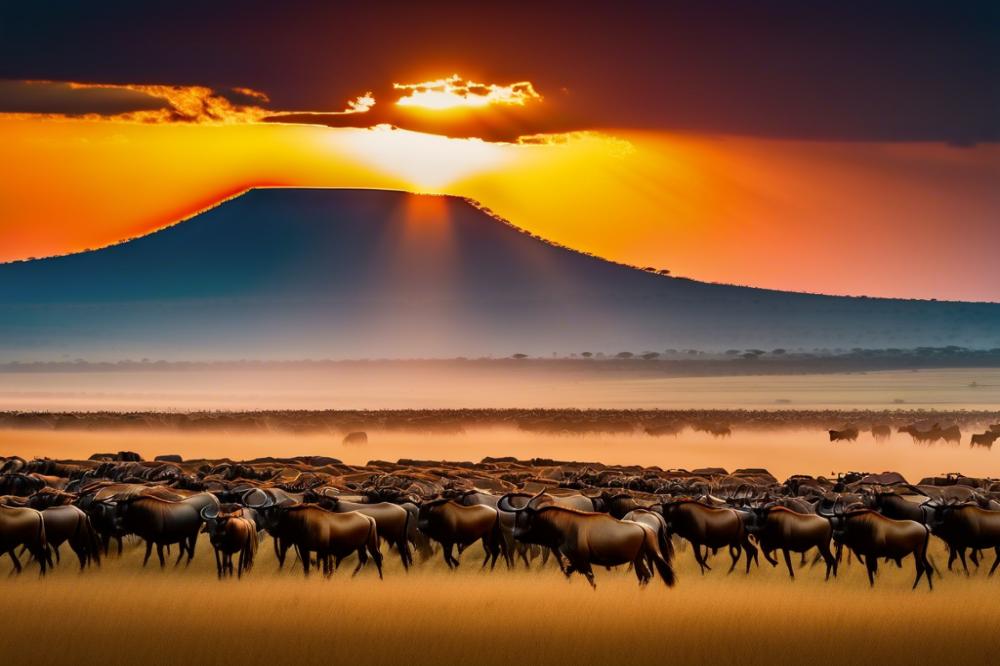Experience the Thrill of Nature’s Great Migration
A large number of travelers seek adventures in Africa, but few experiences compare to witnessing the Wildebeest Migration. This remarkable event features thousands of wildebeests, zebras, and other animals as they trek through the picturesque landscapes of the Serengeti. Such a journey not only showcases the beauty of nature but also highlights the dynamic cycle of life in the wild.
The migration plays a crucial role in the Serengeti ecosystem. It supports the delicate balance of flora and fauna, allowing many species to thrive. As the herds move, they create new grazing fields, which in turn sustain predators. Every year, this epic animal migration draws wildlife enthusiasts and photographers alike to explore the breathtaking scenery, including the iconic Ngorongoro Crater.
Traveling to Tanzania during this period offers incredible opportunities for eco-tourism and wildlife safaris. Visitors can immerse themselves in the vibrant landscapes while learning about the importance of nature conservation. For those planning a trip, travel tips on the best viewing times and locations can enhance the experience. Whether you are a seasoned adventurer or a curious newcomer, witnessing this natural spectacle will leave an indelible mark on your travel memories.
In summary, the Wildebeest Migration provides an unforgettable adventure. Every moment spent observing the great migration is an invitation to connect with the raw beauty of our planet. From the rugged terrain of the Serengeti to the lush vistas of the Maasai Mara, every angle presents a chance for stunning photography. Embrace the journey, and discover why this event is a highlight of holiday adventures in Africa.
Understanding the Wildebeest Migration
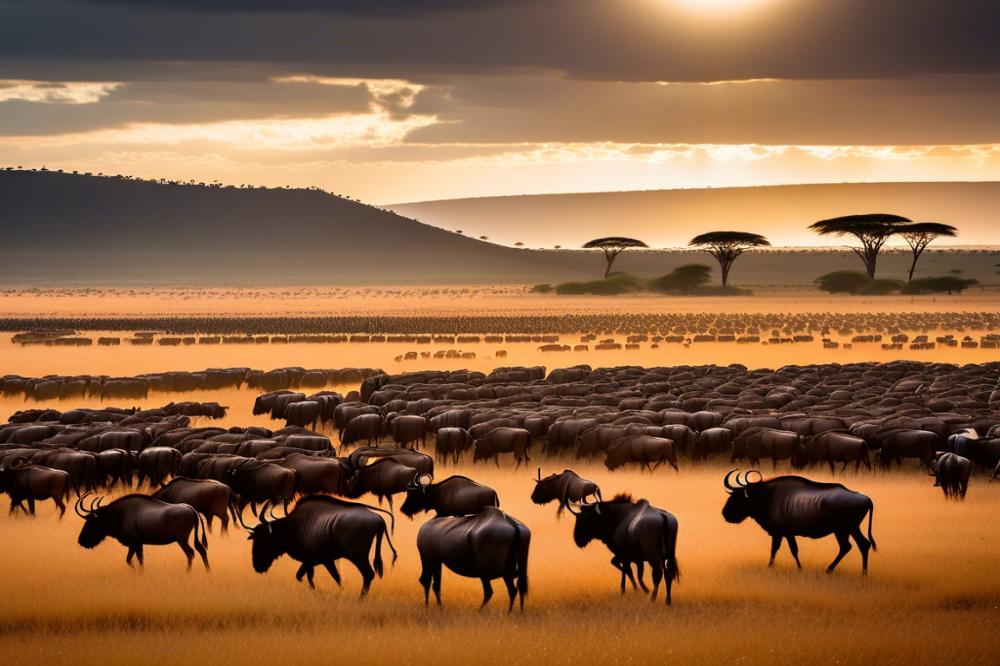
The great migration is one of nature’s most astonishing events. Each year, millions of wildebeests, along with zebras and gazelles, travel across vast landscapes of Africa. This journey is crucial for their survival and sustains the ecosystem. The migration helps maintain a balance in the Serengeti and Maasai Mara regions, providing food and habitat for various wildlife. Many travelers visit these areas to witness this spectacle, making it a top draw for eco-tourism.
Timing and Route
Traditionally, animal migration happens in a cyclical pattern, dictated by weather and availability of grazing. From December to March, wildebeests gather in the Serengeti for birthing season. Young calves are born, increasing the population. As the grasses begin to dry out, they start their journey northward towards the Maasai Mara by June. The route they take crosses rivers, with the most dangerous part being the river crossings filled with crocodiles. Those crossings are moments filled with tension, providing stunning opportunities for photography.
Seasonal Changes Impacting Migration
Seasons play a critical role in shaping migration patterns. During the rainy season, animals thrive in lush green fields. Dry spells force them to search for water and food, and they tend to migrate in larger groups. Such patterns are not only instinctual but also influenced by climate changes. Understanding the seasonal behavior of these animals is vital for anyone interested in a wildlife safari or nature conservation. Observers should take note of how these seasonal shifts affect all wildlife in the area.
Exploring Tanzania‘s Best Locations for Viewing
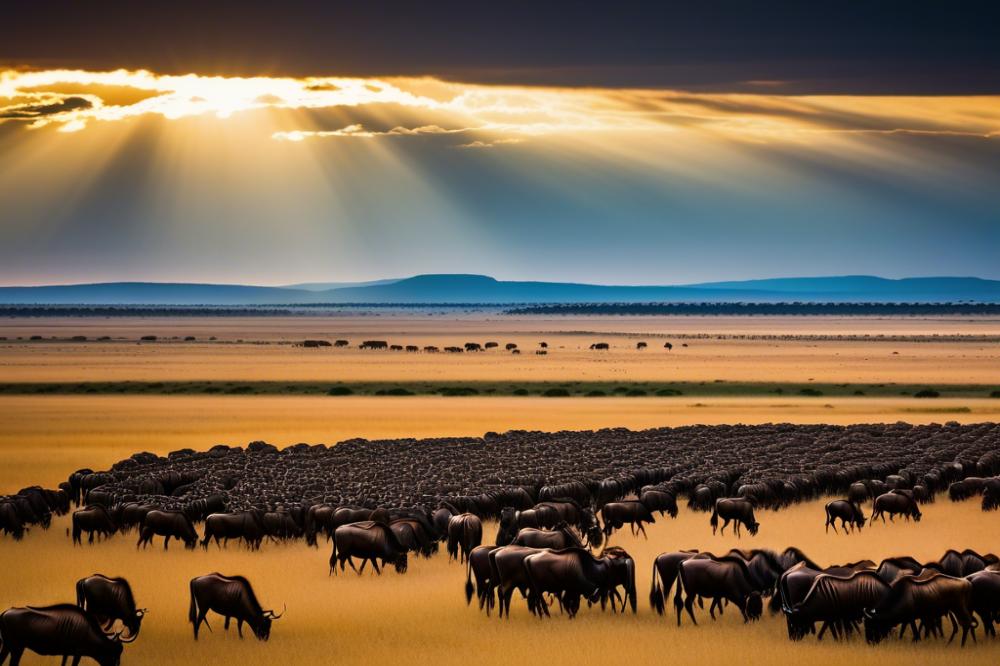
In Tanzania, a few key areas shine for those wishing to observe the great migration. These hotspots are filled with vibrancy and life, offering unforgettable wildlife experiences. The Serengeti National Park is one of the top locations. It extends for miles, presenting an impressive landscape that changes with the seasons. Open plains give way to acacia woodlands and riverine forests. Such diversity allows for varied animal sightings throughout the year.
During the migration, thousands of wildebeest make their way through the Serengeti. This natural spectacle is best viewed from June to September. However, the journey doesn’t stop there. The animals cross into the Maasai Mara in Kenya, where they are met with lush grasslands. Witnessing this animal migration is a once-in-a-lifetime opportunity for many visitors.
Serengeti National Park and Ngorongoro Crater
Another highlight is the Ngorongoro Crater. This UNESCO World Heritage site is a stunning natural bowl that houses incredible wildlife. Towering cliffs encircle the crater floor, creating a unique habitat. Many animals thrive here, including lions, elephants, and rhinos. These creatures roam freely, offering fantastic chances for wildlife photography.
Both the Serengeti and Ngorongoro Crater play vital roles in Tanzania’s eco-tourism. Travelers seeking adventure and a deep connection to nature find their dreams fulfilled here. A wildlife safari in these areas allows individuals to engage directly with the environment. Travelers can learn about conservation efforts while enjoying the breathtaking landscapes.
Many visitors often share travel tips that emphasize the importance of timing your visit. Early mornings or late afternoons provide the best lighting for photography and active wildlife. Consider how different ecosystems contribute to the overall experience. From the flat plains of the Serengeti to the verdant slopes of the Ngorongoro Crater, each place offers its own charm and character.
In summary, exploring these incredible locations will enhance your wildlife experience. Being surrounded by diverse ecosystems truly deepens appreciation for animal life and nature conservation. Your adventure in Tanzania will undoubtedly leave lasting memories that resonate long after you return home.
Wildlife Safari Experience
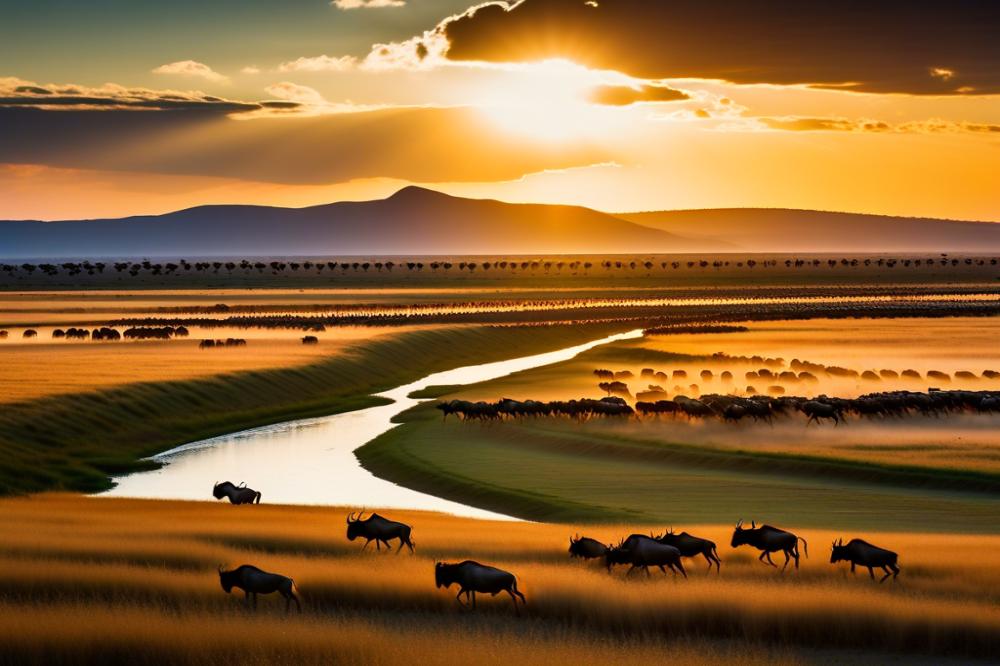
Types of Safari Options Available During the Migration
Traveling during the great migration will allow you to witness unforgettable wildlife moments. There are several safari options to choose from. Guided tours offer structured experiences with skilled professionals. These experts bring knowledge about animal behavior and the best viewing locations. Self-drive safaris provide more freedom to explore at your own pace. This option is perfect for adventurers who prefer a more personal journey. Whether you prefer a guided tour or a self-drive option, both have their charm. Tourists often flock to regions like the Serengeti and Maasai Mara for rich wildlife encounters. The flexibility of choice helps every visitor tailor their experience.
Guided Tours vs. Self-Drive Safaris
Choosing between guided tours and self-drive safaris is an important decision. Guided tours come with the advantage of having a local expert. Wildlife guides deeply understand the flora and fauna in these areas. Their insights can enhance your wildlife observation, especially during peak animal migration times. Self-drive safaris let you take control of your adventure. You set your schedule and navigate through stunning landscapes. However, without experience, you might miss hidden sights or critical details. Traveling in the Ngorongoro Crater, for example, requires local knowledge for the best wildlife viewing spots. Always weigh both options carefully.
Importance of Wildlife Guides and Local Expertise
Wildlife guides significantly improve your safari experience. They offer invaluable context that enriches your understanding of nature conservation. Learning about different species and their habitats brings the scenery to life. Without such insight, visitors may overlook the beauty around them. Local guides can also suggest the best times for photography. Imagine capturing breathtaking images of the animals at the right moment. Their familiarity with the land ensures you will have an incredible experience. Embracing eco-tourism means supporting locals who are committed to protecting wildlife. This connection to the community makes your adventure even more rewarding.
Photography Opportunities
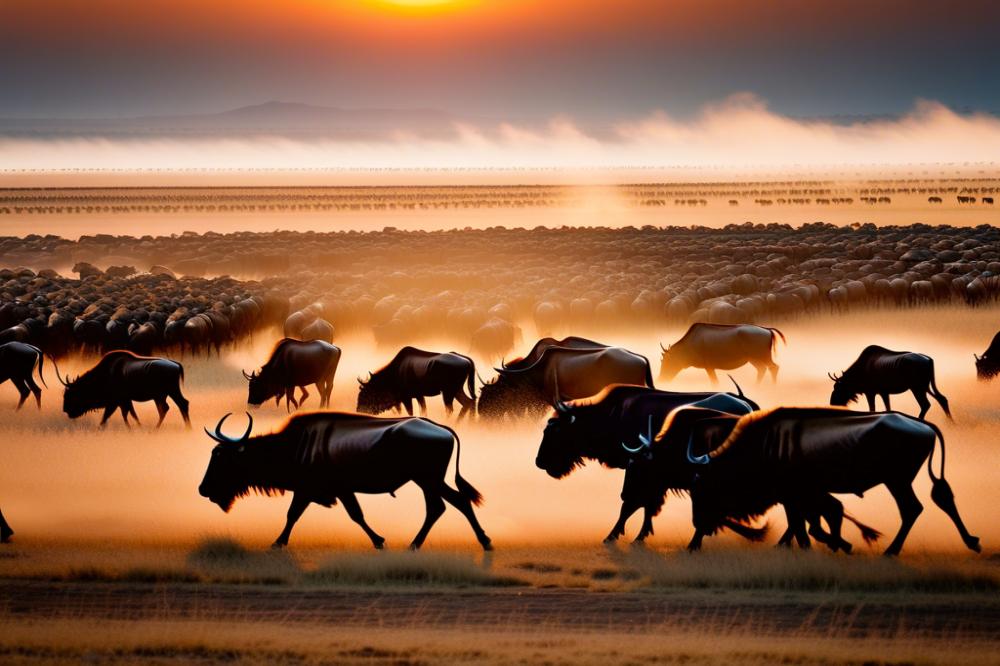
Best Practices for Photography During the Migration
Capturing the great migration is no small task. First, choose the right time of day for your shots. Early mornings and late afternoons provide the best lighting. Plan your movements quietly. Sudden noises can scare away animals. Respecting wildlife is crucial. Stay in your vehicle when encountering animals. Following park regulations helps protect both you and the animals.
Next, consider composition. Frame your subject well. Using the rule of thirds can enhance your images. Avoid clutter in the background. This makes the wildlife stand out more clearly. Take your time with each shot. Patience can reward you with an unforgettable moment.
Recommended Gear and Settings for Capturing Wildlife Moments
Your gear can make or break your safari photography. Start with a camera that has a long lens. Telephoto lenses help capture distant action. A lens with a focal length of 200mm or more is ideal. Bring extra batteries and memory cards. There’s nothing worse than missing a shot because your equipment failed.
Set your camera to continuous shooting mode. This will allow you to capture fast-moving scenes. Use a fast shutter speed to freeze action. A setting of 1/1000 second is often effective. For low light conditions, adjust the ISO accordingly. This helps you get clear shots in various lighting.
Highlighting Unique Photo Spots Within the Serengeti
Specific locations in the Serengeti are famed for exceptional wildlife viewing. The Seronera Valley is perfect for spotting the famous big cats. Here, leopards and lions often roam. Lake Ndutu is another notable area during calving season. Dramatic interactions between predators and prey occur here.
The Ngorongoro Crater offers breathtaking vistas along with rich wildlife. Photographs taken from the crater rim can be stunning. The Maasai Mara is also nearby, providing magnificent backdrops.
Take advantage of these spectacular locations. They are not only visually appealing but also contribute to eco-tourism. Each photo helps tell a story of nature conservation. Remember, every click of the shutter adds to the appreciation of life in the wild.
Travel Tips for Your Adventure
Planning your trip to witness the great migration requires careful thought. Start by choosing the right time of year. The best months to see the migration are between June and October. This period coincides with the dry season in the Serengeti and offers excellent viewing opportunities. The herds move towards the Maasai Mara during this time, making it prime for wildlife safari excursions.
Select your accommodations wisely. Numerous options are available, from luxury lodges to budget-friendly campsites. Many lodges offer guided tours and meals, which adds convenience. Staying in the Ngorongoro Crater also gives you access to incredible wildlife, adding variety to your experience. Booking well in advance can help secure a spot during peak season.
Safety is paramount when exploring the wild. Always follow your guide’s instructions and maintain a safe distance from animals. Understand that these creatures are unpredictable. Carry basic first-aid supplies and stay hydrated throughout your adventure. Being prepared enhances your experience and keeps you focused on the beauty around you.
Cultural interactions can elevate your adventure. Engaging with local communities opens doors to understanding their customs and lifestyles. The Maasai people are particularly welcoming. They often showcase their traditions, offering a glimpse into their rich culture. Participating in their rituals can create memorable moments but be respectful of their practices.
Photography enthusiasts will find countless opportunities for stunning shots. Invest in a good camera or lens; it’s worth it for capturing the vibrant landscapes and incredible animals during your safari. Early morning and late afternoon light offers the best conditions for photos. Don’t forget to protect your gear from dust and moisture.
Consider eco-tourism’s impact on your journey. Look for tours and accommodations that promote nature conservation. Supporting sustainable practices helps preserve the environment and wildlife for future generations. It’s a small but meaningful choice that benefits both nature and local communities.
Be mindful of your expectations. While the migration promises thrilling sights, nature can be unpredictable. Sometimes, the herds may not be exactly where you anticipate. Embrace spontaneity, and prepare to be amazed by the unexpected aspects of the safari.
Incorporating these travel tips into your planning will enhance your experience. A well-thought-out trip fosters enjoyment and appreciation for the breathtaking beauty of Tanzania and its wildlife. Enjoy your time in this remarkable land.
Nature Conservation and Eco-Tourism
Eco-tourism plays a vital role in preserving wildlife and their natural habitats. It encourages responsible travel that focuses on protecting the environment. Travelers can enjoy unique experiences in places like the Serengeti and the Ngorongoro Crater while contributing to conservation efforts. When visitors respect nature, they help support ecosystems that host the great migration and other remarkable animal migration events.
Efforts towards Conservation of the Wildebeest and Other Species
Various organizations work tirelessly to protect species such as wildebeests and other wildlife. These efforts include anti-poaching initiatives and habitat restoration. The local communities are often involved, ensuring that they benefit from eco-tourism. Programs that educate residents about wildlife help them understand the importance of conservation. Awareness fosters a sense of responsibility towards the land and its inhabitants.
How Travelers Can Support Sustainable Practices During Their Visit
Traveling responsibly is essential for anyone visiting these rich ecosystems. Always choose eco-friendly lodges and tour operators. Opt for wildlife safaris that follow strict guidelines to minimize human impact. When taking photographs, remember to respect the animals and their environment. Avoid feeding or touching wildlife, as this disrupts their natural behaviors.
Moreover, travelers can participate in local projects aimed at conservation. Volunteering even for a day can provide invaluable help. Purchasing handmade crafts from local artisans supports the community and promotes sustainable practices. Additionally, learning travel tips about local cultures and environments can enhance your experience while ensuring a positive impact.
Final Thoughts on an Adventure of a Lifetime
Travelers are rewarded with breathtaking experiences when they witness the migration of wildebeest in Tanzania. Imagine standing on the vast plains of the Serengeti, where thousands of these magnificent animals move in a synchronized dance with nature. This grand spectacle is not just a visual feast; it embodies the rhythm of life itself. An adventure like this connects you deeply to the wilderness and shows the raw beauty of the animal kingdom.
Consider taking the journey to see this amazing event firsthand. Eyewitness accounts and photos do little justice to the actual experience. Nothing compares to hearing the thunderous sound of hooves or the sight of dust clouds rising as the herds cross rivers. Visiting iconic spots like the Ngorongoro Crater offers a chance to see diverse wildlife up close. Each moment spent in these stunning landscapes leaves lasting memories.
Such adventures hold great significance for wildlife conservation. By participating in ecotourism, travelers contribute to the protection of these environments. Your presence can help raise awareness about the importance of these natural spaces. Supporting local communities also plays a role in safeguarding these precious animals for future generations.
Ultimately, witnessing this migration enriches your travel experiences. Embrace the chance to connect with nature and understand its wonders. Each trip fosters a sense of responsibility toward wildlife conservation. As you consider your next adventure, think about how participating in such events can create impactful change. This journey is more than just a vacation; it’s a step toward a better understanding of our world.

